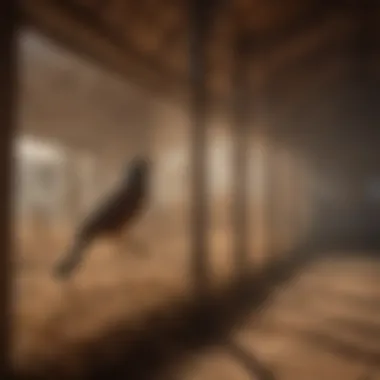Effective Bird Control Strategies for Barns


Intro
Bird infestations in barns can cause numerous issues, ranging from property damage to health concerns. It is imperative to understand effective strategies to deal with these situations. This article offers a detailed analysis of bird control methods, focusing on the identification of species, preventive tactics, humane removal techniques, and sustainable management practices.
By exploring these strategies, homeowners can mitigate the impact of birds on their premises while adhering to ethical and local regulations.
Pest Identification
Understanding which birds are causing the issue is the first step in addressing a barn infestation. Each bird species may require different approaches for effective removal.
Common Household Pests
In barn settings, some common birds include:
- House Sparrows: Small, brownish birds often found in urban areas and barns.
- Starlings: These birds are known for their iridescent feathers and large flocks.
- Pigeons: Frequently found in cities, they can also nest in barns, causing considerable mess.
Identifying these birds correctly is crucial, as approaches can differ.
Signs of Infestation
The presence of birds can be inferred through various signs:
- Nests: Look for nest materials such as twigs, feathers, and droppings in and around the barn.
- Droppings: Accumulated droppings can pose health risks and indicate frequent visits.
- Sounds: Chirping or flapping noises are clear indicators of bird activity.
Recognizing these signs early can prevent larger infestations.
Prevention Methods
Preventing birds from entering the barn is often more effective than removal. This can be achieved through several tactics.
Environmental Modifications
- Seal Entry Points: Close any gaps or openings in the barn where birds can enter.
- Remove Attractants: Limit access to food sources that may draw birds, such as grain or animal feed.
- Alter Surroundings: Consider landscaping modifications, like eliminating perches or nesting sites, including overhanging branches.
Home Maintenance Tips
Routine maintenance is key:
- Regular Inspections: Periodically check for new openings or bird activity.
- Cleanliness: Keep the barn clean by removing droppings and potential nesting materials.
- Use Deterrents: Implement physical barriers or use reflective surfaces to discourage roosting.
DIY Pest Control Solutions
If birds have already made a nest, there are humane and effective solutions to consider.
Natural Remedies
Some natural deterrents can help repel birds without harm:
- Essential Oils: Spraying oils like peppermint or citronella can deter birds due to their strong scents.
- Garlic Spray: Similar to essential oils, garlic can be unappealing to birds.
DIY Traps and Barriers
Consider crafting traps or barriers:
- Netting: Install bird netting to block access to specific areas.
- Traps: Set up humane traps that catch birds without causing injury.
Implementing a combination of these strategies can create a sustainable approach to bird management.
By understanding the methods for identification and preventative measures, homeowners can develop a comprehensive plan to manage bird populations in their barns. This knowledge not only aids in immediate relief but also fosters long-term solutions.
Understanding Bird Behavior
Understanding bird behavior is crucial for effective management and control in a barn setting. Knowledge of how birds interact with their environment can aid in developing targeted strategies to mitigate their presence. This topic focuses on specific elements such as the common species found in barns, the factors that attract birds, and how their activities impact barn functionality.


Common Species Found in Barns
Barns frequently attract various bird species, prominent among them are sparrows, starlings, and pigeons. These birds often seek abundant food sources and suitable nesting sites. For instance, the house sparrow is known for its adaptability and can thrive in urban and rural settings alike. Starlings, particularly, are social birds that often form large flocks, which can exacerbate control challenges due to their sheer numbers. Pigeons, while commonly associated with urban settings, can also be prevalent in agricultural environments. Understanding which species are present is the first step in addressing the issues they cause.
Factors Attracting Birds to Barns
Birds are drawn to barns for several reasons. The primary factors include food availability, shelter, and safety from predators. Excess grain, animal feed, or spilled food provide an irresistible draw. Moreover, barns often present many secluded areas ideal for nesting. The architecture of many barns also offers protection against weather extremes. Recognizing these factors can guide barn owners in modifying their environments to reduce allure.
- Food sources: Spilled feed and stored grain are common attractions.
- Nesting opportunities: Eaves and gaps in structures provide ideal nesting sites.
- Shelter: Barns offer both shelter from elements and protection from predators.
Addressing these factors is key to preventing infestations.
The Impact of Birds on Barn Functionality
Birds can significantly disrupt barn operations. Their presence often leads to contamination of feed and supplies. Droppings from birds, especially pigeons and starlings, can introduce pathogens, potentially harming livestock and affecting food quality. This contamination poses serious risks for both health and economic viability. Additionally, nests and other debris can cause structural damage over time and create fire hazards. Therefore, it is vital for barn owners to understand the full impact of bird activity to implement effective management practices.
"Birds can introduce disease to livestock, further complicating the management of a barn's overall health and safety."
Identifying Signs of Infestation
Understanding the signs of a bird infestation is key in taking action. Early identification helps reduce the chances of significant damage to the barn and its contents. Recognizing the presence of birds promptly ensures that remedial measures can be taken before they become a larger problem. Not only do birds pose health risks, but they can also damage $feed$ supplies and create an unsanitary environment. This section elaborates on two main aspects of identifying signs of infestation: physical evidence and behavioral indicators.
Physical Evidence of Birds
When assessing for a bird infestation, one should first look for specific physical clues that indicate their presence. Common signs include:
- Droppings: Accumulations of droppings are prevalent around areas where birds roost or feed. Bird feces may appear moist or dry and can carry diseases.
- Nests: Identifying nests made of twigs, grasses, or other materials is a clear sign of birds residing in the barn. Nests are often found in wall cavities, rafters, or even on shelves.
- Feathers: Finding feathers scattered around the barn indicates that birds may be nesting or frequenting the area. The location and types of feathers can give clues about the species.
- Damage to Structures: Birds can cause structural damage to a barn through their nesting activities, leading to potential vulnerabilities which might worsen over time.
"Being vigilant for these physical clues can safeguard your barn from extensive infestation issues."
Paying close attention to these signs can help in understanding if birds are a concern that needs addressing.
Behavioral Indicators of an Infestation
In addition to physical evidence, observing bird behavior in and around the barn can provide significant insights. Specific behaviors indicative of an infestation include:
- Frequent Visits: Noticing a consistent presence of birds indicates they have found a suitable habitat. They may come and go frequently, particularly at dawn and dusk.
- Noise Levels: Hearing chirping, cawing, or fluttering sounds suggests birds are nearby. These sounds often increase during nesting seasons when adult birds call for their young.
- Flight Patterns: Observing how birds navigate—if they are entering and exiting specific areas repeatedly—gives clear evidence of where they might be nesting or feeding.
- Aggressive Behavior: Birds may display territorial actions if they perceive threats. Aggressive posturing can indicate that their nesting area is established.
By understanding these behavioral indicators, barn owners can take effective actions to prevent an escalation of nesting and other related issues.
Preventive Measures to Reduce Attraction
Preventive measures play a vital role in effective bird control within barn settings. Understanding how to reduce factors that attract these birds can lead to a more sustainable and less intrusive approach. Taking steps to minimize the allure will significantly decrease the need for other, more aggressive removal methods later. This section discusses several critical strategies to implement immediately.
Sealing Entry Points
Birds are often able to enter barns through seemingly small openings and gaps. To reduce this risk, it's essential to inspect the barn thoroughly, identifying common entry points such as holes in walls, gaps around doors, or openings in the roof. Sealing these areas can be achieved using materials like mesh, wood, or foam sealant, depending on the size of the opening. Furthermore, ensuring doors close completely and fit snugly also helps. By preventing entry, you keep birds from nesting and feeding inside the barn, which protects your supplies and prevents potential damage to the structure itself.
Proper Storage of Feed and Supplies
The storage of feed and supplies is a crucial aspect often overlooked. Birds are drawn to accessible food sources, so keeping all feed in airtight, secure containers is essential. Whn feed is left exposed, it attracts not only birds but other pests as well. Areas where supplies are kept should also be kept clean and organized. When cleaning, avoid leaving any spilled feed or leftovers that might entice birds. Regular monitoring of these areas ensures that food sources do not incentivize bird visits.
Landscape Management Strategies
The surrounding landscape of a barn significantly influences bird activity. Keeping the area around the barn orderly helps discourage birds. This can include cutting down tall grass, trimming overhanging branches, and removing any debris or clutter that could provide cover or nesting materials. Moreover, plants that attract birds should either be removed or replaced with less attractive alternatives. Implementing a thoughtful landscape design not only protects the barn but can enhance its overall appearance.
Maintaining a tidy exterior can discourage birds from roosting nearby.
By focusing on these preventative strategies, barn owners minimize the chances of bird infestations, promoting a more effective long-term management plan.
Humane Bird Removal Techniques
Humane bird removal techniques are essential within the context of bird control in barns. These methods prioritize the well-being of birds while effectively addressing issues related to infestation. Implementing such techniques minimizes harm and promotes a more ethical approach to wildlife management. It is paramount to recognize that birds play a crucial role in ecosystems. Thus, fostering a balanced coexistence with them proves beneficial for everyone involved.
Trapping and Relocation Methods


Trapping is one of the most effective humane removal techniques. This method involves using traps designed specifically to capture birds without harming them. When selecting traps, ensure that they comply with local regulations and are appropriate for the specific bird species found in your barn.
- Types of Traps: Consider using box traps or cage traps, which provide ample space for the birds until you can relocate them. Ensure traps are placed strategically where birds frequently gather, minimizing stress during capture.
- Relocation: After capturing birds, it is essential to relocate them to a suitable environment nearby. This should be done promptly to reduce stress. Research local wildlife rehabilitators or animal control services to inform you about safe relocation practices.
Netting Solutions
Netting serves as a barrier that prevents birds from entering unwanted areas. It is a highly effective method that can be tailored to suit specific barn structures.
- Materials: Choose durable materials designed to withstand various weather conditions. High-density polyethylene netting is a common and effective choice, as it is lightweight yet strong.
- Installation: Ensure proper installation to avoid gaps where birds can enter. Overlapping seams and secure fastenings can enhance effectiveness. Periodic inspections are necessary to confirm that the netting remains intact and functional.
Noise Deterrents
Using noise deterrents can be an effective strategy to discourage birds from nesting in your barn. This approach focuses on creating an environment that is less appealing to birds without causing harm.
- Types of Sound Devices: Consider devices that emit human-made sounds mimicking predators or distress calls. These sounds can deter birds from entering the barn. Ultrasonic devices are also available and are less intrusive.
- Rotation of Sounds: Change the sounds regularly to prevent birds from becoming accustomed to them. A varied approach may be more effective in maintaining deterrence over time.
Implementing these humane techniques not only aligns with ethical standards but also sustains wildlife preservation efforts. By taking care to manage the bird population responsibly, barn owners foster an environment that respects all living creatures.
Chemical and Non-Chemical Control Methods
When considering methods to manage birds in a barn, it is crucial to explore the spectrum of chemical and non-chemical control strategies. Each has its own set of advantages and drawbacks that can influence their effectiveness and suitability for any given situation. Understanding these options can lead to more appropriate and informed decisions.
Chemical methods often involve the use of repellents and various pest control products. These can deter birds from frequenting a barn but come with considerations regarding safety and environmental impact. Chemical repellents, for instance, may provide immediate effects. However, many homeowners express concerns about their usage around livestock and the potential for residual effects on the barn environment. Safety should always be a priority.
On the other hand, non-chemical methods focus on prevention and behavioral deterrence. These approaches might include physical barriers and modifications to the barn environment to make it less inviting for birds. Utilizing these methods often aligns better with sustainability principles. When paired with the right monitoring practices, they can lead to long-lasting results without the potential complications that chemicals may introduce.
Ultimately, the choice between chemical and non-chemical approaches depends on specific circumstances and preferences, emphasizing the need for a customized strategy.
Using Repellents Effectively
Repellents are a common method in bird control. Their ease of use makes them appealing to many barn owners. When using repellents, it is important to choose products designed specifically for avian pests. There are many types available, such as liquid sprays, granules, or even gels that can be applied to surfaces where birds tend to roost.
To maximize effectiveness, consider the following tips:
- Apply in strategic locations: Focus on areas with heavy bird traffic, like ledges and nesting sites.
- Follow instructions carefully: Always adhere to the guidelines provided by the manufacturer. Improper application can reduce effectiveness.
- Monitor effectiveness: Check regularly to assess if the repellent is working and if reapplication is necessary.
Using repellents requires a thoughtful approach. Combining them with non-chemical methods can enhance long-term outcomes.
Pest Control Products and Their Efficacy
Various pest control products are available on the market for managing bird populations. These include both traps and deterrents. Understanding their efficacy is vital. Different products may work better for specific bird species and infestations. Moreover, responses to these treatments can vary.
When evaluating these products, consider:
- Target species: Ensure the product is intended for the species causing the issue. For example, some formulations are effective against pigeons, while others may work for sparrows.
- Environmental impact: Look for products that minimize harm to other wildlife and the environment. Read reviews and check if the product has environmentally friendly endorsements.
- Longevity: Assess how long the product remains effective. Ongoing management can become costly if products must be frequently replaced.
"Using targeted pest control products reduces not only bird populations but the risk of property damage caused by infestations."
Long-term Management Strategies
Effective long-term management of birds in a barn context is essential. It goes beyond temporary fixes and grips the overarching principles of pest control and ecosystem balance. Implementing sustainable strategies ensures that barns remain functional and conducive for their intended use, without being overrun by unwanted avian guests.
Benefits of these strategies include maintaining cleanliness, enhancing barn usability, and protecting livestock from potential harm brought by birds. Additionally, long-term strategies often lead to reduced costs in pest control services over time, contributing to a more sustainable farm operation.
Monitoring Bird Activity
Monitoring bird activity is a critical aspect of long-term management. By keeping a close watch on which species are present and when, barn owners can make informed decisions. Each species may have specific times of day they are active, and understanding these patterns can help in planning preventive measures.
Methods for monitoring may include:
- Regular visual checks: Observing the barn at different times helps identify peak times for bird presence.
- Install cameras: Using surveillance cameras can provide insights without constant human presence.
- Trapping data: If trapping is done, the data collected can reveal patterns and populations.
Community Involvement and Awareness


Community involvement is beneficial. Engaging neighbors or local agricultural organizations can foster an environment of shared knowledge. Proper bird management often requires collective efforts since birds do not recognize individual property lines.
Consider organizing community workshops or information sessions. This enhances awareness of effective bird control strategies while spreading knowledge about local species and their behaviors.
Key points for community involvement include:
- Education events: Teach residents about non-harmful strategies for managing birds.
- Resource sharing: Pooling resources helps to maximize outreach and reduce costs.
- Collaboration with local wildlife experts: Ensure that management practices adhere to ethical guidelines.
Sustainable Practices for Bird Control
Sustainable practices form the backbone of effective bird control. They allow barn owners to manage bird populations over time without resorting to harmful pesticide methods.
Examples of sustainable practices include:**
- Creating an inhospitable environment: Modifying the barn's layout or using certain materials can deter birds.
- Using bird-friendly plants around the barn: This attracts natural predators instead of creating an enticing environment for birds.
- Regular maintenance: Sealing holes and keeping the barn tidy reduces nesting opportunities.
Sustainability ensures that bird control methods do not disrupt the local ecology. By adopting these approaches, barn owners can fulfill their responsibilities toward their livestock and the environment alike.
It is essential to remember that responsible management is not merely about eradication; it is about finding the right balance.
Legal Considerations
Understanding the legal landscape surrounding bird control is crucial for anyone dealing with infestations in a barn. Many jurisdictions have specific regulations that govern how birds can be managed. These laws exist to protect wildlife and ensure humane treatment. Ignoring these regulations can lead to significant legal consequences, including fines and penalties.
Moreover, awareness of local guidelines helps maintain a balance between effective pest management and environmental protection. This section will explore local regulations and ethical considerations that are pertinent when dealing with bird control in a barn setting.
Local Regulations Regarding Bird Control
Local regulations can vary significantly by region. It is essential to research and understand the laws applicable in your area before taking action against birds. For instance, some species of birds may be protected under federal or state law. The Migratory Bird Treaty Act, for example, protects many native bird species, prohibiting their capture, killing, or possession without proper permits.
Homeowners should consult their local wildlife agency or agricultural department to obtain relevant information regarding bird control. This can include:
- Permits: Some methods of control require permits. Always check if your approach aligns with local laws, especially in regard to traps or netting.
- Species Protection: Identifying if the birds are part of a protected species is pivotal. Actions taken against such birds can result in legal repercussions.
- Reporting: Certain situations may require reporting specific bird populations to local authorities to ensure compliance with regulations.
Following local regulations not only protects the birds but also shields you from potential penalties.
Ethical Considerations in Bird Management
Beyond legality, the ethical aspect of bird management must be taken into account. Choosing humane methods of control reflects a commitment to responsible stewardship of wildlife. It is important to focus on options that minimize suffering and stress to the birds. Ethical practices include:
- Non-lethal Removal: Employ methods that do not harm the birds, such as trapping and relocating them safely.
- Safe Environments: Consider the safety and welfare of birds in your actions. This includes ensuring that any traps used are effective yet humane.
- Awareness Campaigns: Raising awareness in your community about the importance of bird species can help foster cooperative approaches to management, encouraging respect for wildlife.
The integration of ethical considerations into your bird management strategy can enhance the effectiveness of your actions while promoting sustainable practices.
"Understanding and adhering to legal requirements helps ensure we treat all creatures with dignity and respect."
Resources for Further Information
Understanding how to deal with bird issues in barns requires ongoing education and awareness. This section of the article provides valuable resources for homeowners and pest control professionals alike. The importance of accessible information cannot be overstated. It empowers individuals to make informed decisions about bird control methods while keeping ethical considerations in mind. Resources cover a wide range of topics related to bird behavior, effective prevention strategies, and local regulations.
Having access to comprehensive guides promotes better understanding of the impact birds can have, their nesting habits, and the potential risks associated with infestations. Additionally, it opens avenues for finding community support and expert advice to manage bird populations effectively. By leveraging resources, individuals can choose approaches that do not harm the environment, ensuring the well-being of both property and wildlife.
Recommended Reading on Bird Control
Reading is an essential part of expanding knowledge about bird control. Many books and articles focus on the nuances of bird behavior and control methods. Resources may include case studies, practical guidance, and innovative solutions tailored to various environments.
- "Birds in the Barn: Understanding Their Presence" - This book explores common species seen in barns and their behaviors. Understanding these factors can help in applying effective control methods.
- "Humane Bird Control Techniques" - A comprehensive guide that discusses various humane strategies for bird removal and management, emphasizing a sustainable approach.
- Online Articles - Websites like Britannica and Wikipedia offer quick references about specific bird species and management techniques.
This reading not only enhances one’s knowledge but also prepares one for practical applications of bird control in a barn setting.
Professional Pest Control Services
For some homeowners, the most effective solution might involve consulting with professionals. Pest control services specialize in bird removal and can offer insights that individuals may not possess. They can assess the extent of an infestation quickly and recommend tailored strategies. Professional services typically abide by local regulations, ensuring methods are both effective and legal.
When searching for pest control services, consider the following:
- Certifications: Ensure they are licensed and have experience in humane bird control.
- Reviews and References: Look for testimonials from other clients, which can provide a good indication of service quality.
- Range of Services: Some companies might provide additional services such as bird-proofing your barn, not just removal.
Engaging a professional can bring peace of mind, ensuring that birds are dealt with humanely and efficiently.















